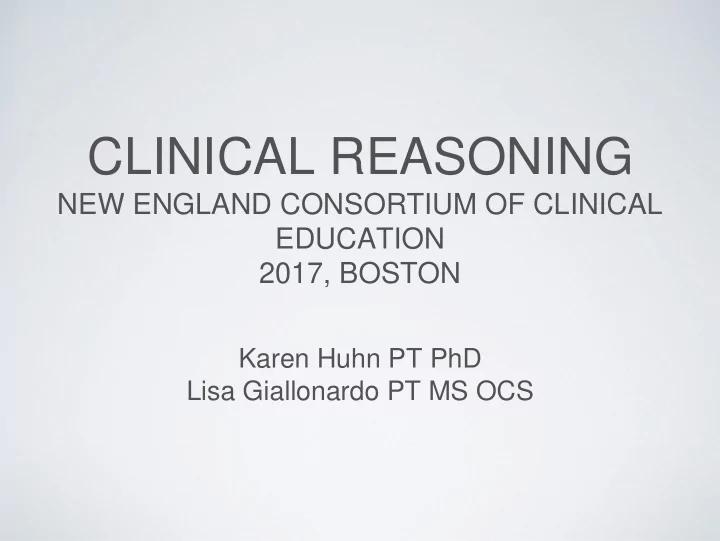

CLINICAL REASONING NEW ENGLAND CONSORTIUM OF CLINICAL EDUCATION 2017, BOSTON Karen Huhn PT PhD Lisa Giallonardo PT MS OCS
OBJECTIVES • By the end the CFI, participants will be able to answer the following questions: • What is clinical reasoning? • How do you facilitate clinical reasoning, particularly in the clinic? • How do you assess clinical reasoning?
CLINICAL REASONING • What is it? • A Skill? • A Habit? • A Trait?
WE ASKED ACADEMIC AND CLINICAL EDUCATORS
FINDINGS • Both academic and clinical educators value CR • Academic: explicitly integrated into curricula, not consistently defined, taught or assessed within or between programs- significant variability in CR education • Clinical: CIs see the importance of clinical experiences and engaged discussion to foster the development of clinical reasoning. The majority of clinical educators did not expect students to achieve “entry-level” clinical reasoning skills as defined by the Clinical Performance Instrument by the final year of students’ education.
DEFINITIONS • Clinical reasoning is a nonlinear, recursive cognitive process in which the clinician synthesizes information collaboratively with the patient, caregivers, and the health care team in the context of the task and the setting. The clinician reflectively integrates information with previous knowledge and best available evidence in order to take deliberate action. CR Consortium 2015 • Clinical reasoning in physical therapy can be conceptualized as integrating cognitive, psychomotor and affective skills. It is contextual in nature and involves both therapist and client perspectives. It is adaptive, iterative and collaborative with the intended outcome being a biopsychosocial approach to patient/client management. CR Consortium 2017
COMPONENTS
TYPES OF REASONING • Collaborative • Narrative • Procedural • Ethical • Analytic • Non-analytic • Intuitive • Dialectical
TEACHING AND ASSESSING CLINICAL REASONING • Continuum • must meet student where they are and help them move to the next level
NOVICE TO ADVANCED BEGINNER • Rely on basic science • No context • Patient is not the center • Checklist, single approach • Focus is on self-What am I missing, have I done everything • Unreflective • Rely on taught rules
INTERMEDIATE • Gain increased knowledge and competence • Begin to cope with multiple factors-context • Prioritize • Begin to use and form routines • Hypothesis testing • Moving toward competent and proficient • Begin reflecting on and in action • Begin to start including the patient
ADVANCED • Begin to acquire expertise • Intuition begins to develop • Flexible in thinking and planning • Reflection on action, for action • Exemplars from previous experience • Patient is center, included in process
ADAPTIVE TEACHING • Adjust to where the student is • May be at different level (novice, intermediate, advanced) depending on familiarity with patients/contexts
NOVICE/ADVANCED BEGINNER • Help them scaffold or make links between data gathered and relevance, priority • Provide structure • Encourage a one line statement of patient problem • Begin with common representation and move to uncommon • Help build illness script: how is this patient different from previous ones with similar diagnosis • Identify key problems/features • Encourage student to consider all possibilities and talk about what fits and what doesn’t • Make links between biomedical knowledge and clinical representation: • acute vs. it started a few days ago
INTERMEDIATE • Goal: refine analytic reasoning while developing non analytical reasoning • Lots of patient experience with lots of discussion before and after, feedback • Highlight key features • Make reasoning explicit “tell me your ideas” • Help them explicitly prioritize and identify relevance for each piece of data • Advocacy/Inquiry • I noticed……, tell me what you were thinking • Repetitive deliberate practice
ADVANCED • Often form an idea quickly (non analytical) • Even more clinical practice in various settings with variable complexity • Offer a lot of opportunity for critical self-reflection • When to slow down, when to proceed • Talk to them about your own errors, model self-monitoring • Talk to them about predicting results based on initial thoughts, hypothesis, how did that compare to the outcome?
ADAPTIVE Remember that this is not a linear progression, you will need to adjust your teaching level for different patients and contexts
ASSESSING CLINICAL REASONING • No “gold standard” • Continuum and variety of tools • must assess at the level appropriate for the level of student • Assessment as teaching tool
ASSESSING CLINICAL REASONING • Standardized tests • CCTST, CCTDI, HSRT • Critical thinking
ASSESSMENT • Knows • Knows how • Shows how • Does
Recommend
More recommend